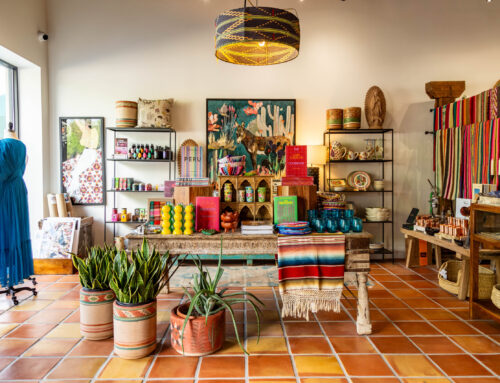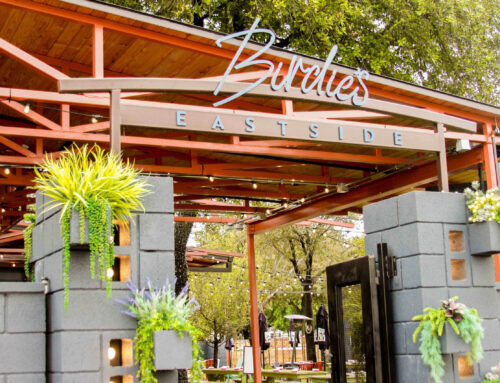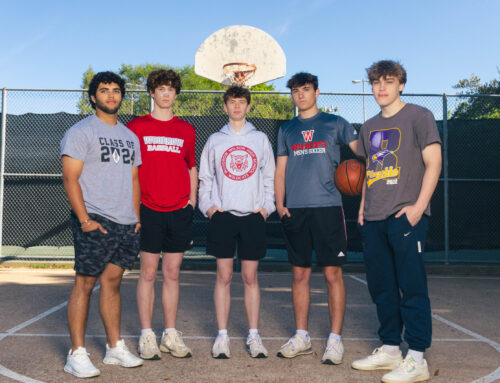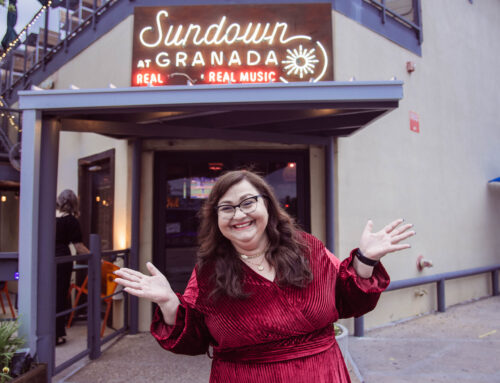That’s how Norman Alston and Brandon Castillo view the Lakewood Shopping Center.

In their dreams for what Lakewood Shopping Center could be, architect Norman Alston and
economic developer Brandon Castillo envision a “mini Klyde Warren Park” all across La Vista.
“You have this downtown infrastructure with a suburban shopping mall feel,” Castillo says. “It doesn’t have a sense of place; it’s just a strip of shops and restaurants. It needs public spaces.”
Castillo is the founder of the Deep Ellum Outdoor Market and his economic development firm focuses on “neighborhood-level improvements.” His specialty is pop-up markets, food festivals and other conduits of “vibrant street life.” Alston, a longtime Hollywood-Santa Monica resident, is an architect who specializes in historic preservation and recently was retained by the Lakewood Theater owners to guide them through the landmark designation process. The pair work together on the Dallas Homeowners League board, which coalesces neighborhoods to address issues.
“Lakewood Shopping Center functions, the businesses are full, it’s in a good spot, but it’s not as great a space as it could be, as it has been in the past,” Alston says. “It’s a commercial success; it needs to be a community success.”
• “Say we shut down car activity on La Vista,” Castillo says. They want to (1) recreate the concrete stretch between Abrams and Paulus for pedestrians. Alston says the “you’re not headed downtown so you’re not a priority” approach to infrastructure needs to end. “This is all built to get people on the other side of White Rock Lake to downtown Dallas,” Alston says. “What do we owe cross-town traffic? Nothing, really. Anything we do is going to inconvenience someone trying to go to work in the morning, including myself, but this will become a space that I’m going to enjoy.” It should be a place for interaction, for people-watching, for music, for artists and craftspeople, and for other activities that bring life, energy and variety to the shopping and dining experience, they say. They chose La Vista because “it will interfere least with existing businesses,” Alston says, “and my theory is if you shut down parking in front of a business, you’re going to make them madder than a hornet.”
• As part of the pedestrian mall, Castillo suggests creating a triangular plaza where Paulus, La Vista and Gaston intersect in front of Lakewood Towers, better known to neighbors as the Wells Fargo Bank building. “There’s already a fountain there and mature trees,” Castillo points out. “We want to make it permeable to that side of Gaston,” Alston adds. This combined with the shut down of car activity would create “a mini Klyde Warren Park all through La Vista.” The popular downtown park has demonstrated Dallas’ need for good public spaces throughout the city, Castillo says. “The great thing about Lakewood is that it doesn’t need millions and millions of dollars to replicate Klyde Warren Park’s success,” he says. “How can we assure people are at the Lakewood Shopping Center in the mornings, the afternoons and the evenings? Just give us places to park our bikes and eat frozen yogurt.”
• Gaston, especially between Abrams and Paulus, needs a “road diet,” Castillo says. “It’s four lanes of cars zooming by.” They would reduce total lanes to three (2), with space from the existing fourth lane reallocated for additional parking, wider sidewalks and bicycle lanes. This would slow traffic and create more dedicated space for pedestrians and cyclists.
• Castillo also wonders whether Abrams needs a road diet where it curves around the shopping center south of Gaston. What they did instead was create a roundabout (3) where Abrams meets Gaston that marks a northern “gateway” to the neighborhood, Alston says. A second roundabout (5) at Abrams and Paulus marks the southern “gateway” and together create a “compromise” for drivers, Alston says — they would slow cars curving around and moving through Downtown Lakewood but also would eliminate the Gaston-Abrams traffic signal, “giving through travelers the option of transitioning without having to stop, saving a little time.” They also want a pedestrian gateway (4) from the neighborhoods to the east in the form of an enhanced crosswalk between the existing Graham Park and the new La Vista pedestrian mall.
• To make the shopping center more cohesive, some of the suburban-style businesses should be converted to more urban structures that complement the remaining original buildings, they say. For example, 7-Eleven (6) could move so that the front aligns with Paciugo. Alston and Castillo also would replace the Jiffy Lube building (7) with a continuation of the successful shops — Zoe’s, Talulah Belle and so on — adjacent to it, and eliminate a row of parking in front of these stores to give additional space for patron use. “Who wouldn’t like to see a patio in front of Scalini’s?” Alston asks. Then the odd street configuration currently in front of Jiffy Lube gives way to green space. The circa 1968 suburban-style Jack-in-the-Box (8) and the sea of parking in which it is set should be redeveloped as urban commercial stores, they say, so that the style of the adjacent Starbucks, Frost Bank, etc. continues around the corner, down Gaston. They would also convert the Bank of America site (9) across from Jack in the Box so that the commercial space fronts the streets with sidewalks wide enough for patios, trees or other pedestrian-friendly features. Similarly, they would stretch the commercial space adjacent to Compass Bank (10) to Abrams.
• Parking solutions are noticeably missing in Castillo and Alston’s vision, and that’s on purpose. Parking is “the stickiest problem right now,” Alston says, and he believes a parking study should be conducted. “To me the overriding concern is if the tenants think there isn’t enough parking,” he says.
Ultimately, Alston and Castillo believe the Lakewood Shopping Center has ample room for improvements that could benefit both neighbors and businesses. The obstacles to such improvements loom large, not the least of which is four different owners — and that’s just the section south of Gaston.
But that’s not uncommon, says Alston, who has experience with historic projects in rural towns all over Texas.
“Downtown Lakewood is just like every other small town downtown I’ve ever seen — fractured ownership, no single management structure, a lot of things going in different directions,” Alston says.
“It’s like a real neighborhood, but it could be better,” he continues. “There needs to be coordination, they need to be helping one another. This is an effort to give everybody a point of departure.”
See all stories for Dreams and reality: Lakewood Shopping Center





